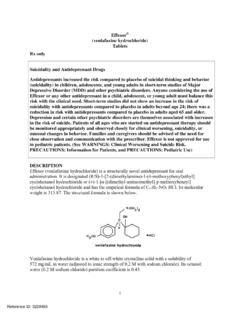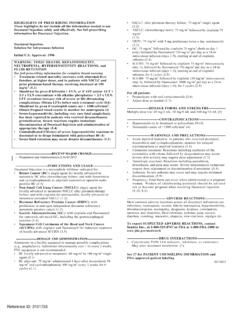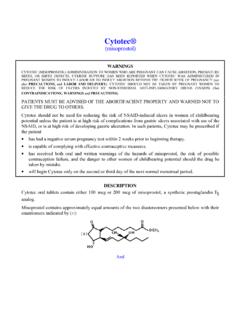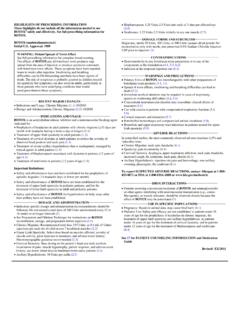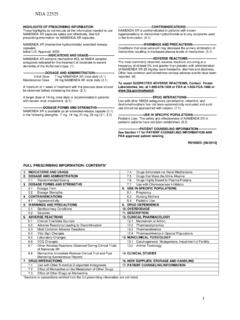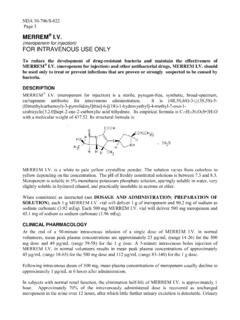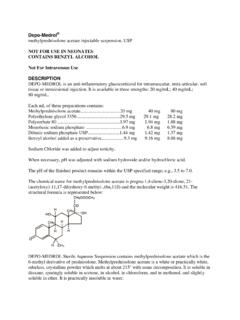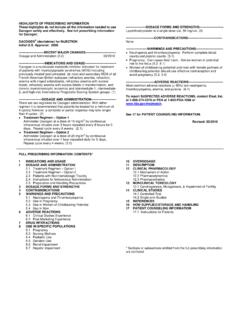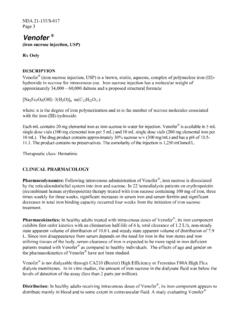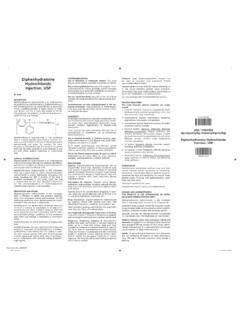Transcription of Inderal (propranolol hydrochloride) Tablets DESCRIPTION ...
1 Inderal ( propranolol hydrochloride ) Tablets Rx only This product's label may have been revised after this insert was used in production. For further product information and current package insert, please visit or call our medical communications department toll-free at 1-888-383-1733 DESCRIPTION Inderal ( propranolol hydrochloride ) is a synthetic beta-adrenergic receptor blocking agent chemically described as 2-Propanol, 1-[(1-methylethyl)amino]-3-(1-naphthalen yloxy)-, hydrochloride ,( )-. Its molecular and structural formulae are: propranolol hydrochloride is a stable, white, crystalline solid which is readily soluble in water and ethanol. Its molecular weight is Inderal is available as 10 mg, 20 mg, 40 mg, 60 mg, and 80 mg Tablets for oral administration.
2 The inactive ingredients contained in Inderal Tablets are: lactose, magnesium stearate, microcrystalline cellulose, and stearic acid. In addition, Inderal 10 mg and 80 mg Tablets contain FD&C Yellow No. 6 and D&C Yellow No. 10; Inderal 20 mg Tablets contain FD&C Blue No. 1; Inderal 40 mg Tablets contain FD&C Blue No. 1, FD&C Yellow No. 6, and D&C Yellow No. 10; Inderal 60 mg Tablets contain D&C Red No. 30. CLINICAL PHARMACOLOGY General propranolol is a nonselective beta-adrenergic receptor blocking agent possessing no other autonomic nervous system activity. It specifically competes with beta-adrenergic receptor agonist agents for available receptor sites. When access to beta-receptor sites is blocked by propranolol , the chronotropic, inotropic, and vasodilator responses to beta-adrenergic stimulation are decreased proportionately.
3 At dosages greater than required for beta blockade, propranolol also exerts a quinidine-like or anesthetic-like membrane action, which affects the cardiac action potential. The significance of the membrane action in the treatment of arrhythmias is uncertain. Reference ID: 2919389 1 Mechanism of Action The mechanism of the antihypertensive effect of propranolol has not been established. Factors that may contribute to the antihypertensive action include: (1) decreased cardiac output, (2) inhibition of renin release by the kidneys, and (3) diminution of tonic sympathetic nerve outflow from vasomotor centers in the brain. Although total peripheral resistance may increase initially, it readjusts to or below the pretreatment level with chronic use of propranolol .
4 Effects of propranolol on plasma volume appear to be minor and somewhat variable. In angina pectoris, propranolol generally reduces the oxygen requirement of the heart at any given level of effort by blocking the catecholamine-induced increases in the heart rate, systolic blood pressure, and the velocity and extent of myocardial contraction. propranolol may increase oxygen requirements by increasing left ventricular fiber length, end diastolic pressure, and systolic ejection period. The net physiologic effect of beta-adrenergic blockade is usually advantageous and is manifested during exercise by delayed onset of pain and increased work capacity. propranolol exerts its antiarrhythmic effects in concentrations associated with beta-adrenergic blockade, and this appears to be its principal antiarrhythmic mechanism of action.
5 In dosages greater than required for beta blockade, propranolol also exerts a quinidine-like or anesthetic-like membrane action, which affects the cardiac action potential. The significance of the membrane action in the treatment of arrhythmias is uncertain. The mechanism of the antimigraine effect of propranolol has not been established. Beta-adrenergic receptors have been demonstrated in the pial vessels of the brain. The specific mechanism of propranolol 's antitremor effects has not been established, but beta-2 (noncardiac) receptors may be involved. A central effect is also possible. Clinical studies have demonstrated that Inderal is of benefit in exaggerated physiological and essential (familial) tremor.
6 PHARMACOKINETICS AND DRUG METABOLISM Absorption propranolol is highly lipophilic and almost completely absorbed after oral administration. However, it undergoes high first-pass metabolism by the liver and on average, only about 25% of propranolol reaches the systemic circulation. Peak plasma concentrations occur about 1 to 4 hours after an oral dose. Administration of protein-rich foods increase the bioavailability of propranolol by about 50% with no change in time to peak concentration, plasma binding, half-life, or the amount of unchanged drug in the urine. Distribution Approximately 90% of circulating propranolol is bound to plasma proteins (albumin and alpha1 acid glycoprotein). The binding is enantiomer-selective.
7 The S(-)-enantiomer is preferentially bound to alpha1 glycoprotein and the R(+)-enantiomer preferentially bound to albumin. The volume of distribution of propranolol is approximately 4 liters/kg. propranolol crosses the blood-brain barrier and the placenta, and is distributed into breast milk. Reference ID: 2919389 2 Metabolism and Elimination propranolol is extensively metabolized with most metabolites appearing in the urine. propranolol is metabolized through three primary routes: aromatic hydroxylation (mainly 4-hydroxylation), N-dealkylation followed by further side-chain oxidation, and direct glucuronidation. It has been estimated that the percentage contributions of these routes to total metabolism are 42%, 41% and 17%, respectively, but with considerable variability between individuals.
8 The four major metabolites are propranolol glucuronide, naphthyloxylactic acid and glucuronic acid, and sulfate conjugates of 4-hydroxy propranolol . In vitro studies have indicated that the aromatic hydroxylation of propranolol is catalyzed mainly by polymorphic CYP2D6. Side-chain oxidation is mediated mainly by CYP1A2 and to some extent by CYP2D6. 4-hydroxy propranolol is a weak inhibitor of CYP2D6. propranolol is also a substrate of CYP2C19 and a substrate for the intestinal efflux transporter, p-glycoprotein (p-gp). Studies suggest however that p-gp is not dose-limiting for intestinal absorption of propranolol in the usual therapeutic dose range. In healthy subjects, no difference was observed between CYP2D6 extensive metabolizers (EMs) and poor metabolizers (PMs) with respect to oral clearance or elimination half-life.
9 Partial clearance of 4-hydroxy propranolol was significantly higher and of naphthyloxyactic acid significantly lower in EMs than PMs. The plasma half-life of propranolol is from 3 to 6 hours. Enantiomers propranolol is a racemic mixture of two enantiomers, R(+) and S(-). The S(-)-enantiomer is approximately 100 times as potent as the R(+)-enantiomer in blocking beta adrenergic receptors. In normal subjects receiving oral doses of racemic propranolol , S(-)-enantiomer concentrations exceeded those of the R(+)-enantiomer by 40-90% as a result of stereoselective hepatic metabolism. Clearance of the pharmacologically active S(-)- propranolol is lower than R(+) propranolol after intravenous and oral doses. Special Populations Geriatric In a study of 12 elderly (62-79 years old) and 12 young (25-33 years old) healthy subjects, the clearance of S(-)-enantiomer of propranolol was decreased in the elderly.
10 Additionally, the half-life of both the R(+)- and S(-)- propranolol were prolonged in the elderly compared with the young (11 hours vs. 5 hours). Clearance of propranolol is reduced with aging due to decline in oxidation capacity (ring oxidation and side-chain oxidation). Conjugation capacity remains unchanged. In a study of 32 patients age 30 to 84 years given a single 20-mg dose of propranolol , an inverse correlation was found between age and the partial metabolic clearances to 4-hydroxypropranolol (40HP-ring oxidation) and to naphthoxylactic acid (NLA-side chain oxidation). No correlation was found between age and the partial metabolic clearance to propranolol glucuronide (PPLG-conjugation). Reference ID: 2919389 3 Gender In a study of 9 healthy women and 12 healthy men, neither the administration of testosterone nor the regular course of the menstrual cycle affected the plasma binding of the propranolol enantiomers.
